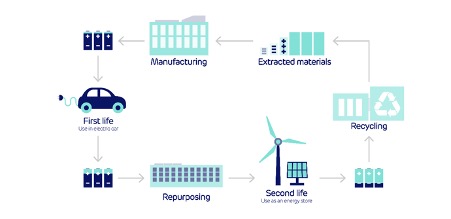It’s widely accepted that electric vehicles (EVs) are more sustainable than their internal combustion (ICE) counterparts. But while EVs reduce carbon emissions, there are still debates around the sustainability credentials of EV batteries.
Contrary to what sceptics might say, EV batteries don’t need to end up in landfill after their use in a vehicle. In fact, they have multiple lives beyond that. Let’s explore them.
First life: life in an electric vehicle
Today, most EV batteries have a life expectancy of 15-20 years within a car – far longer than the average 3-5 years for an ICE vehicle. Manufacturers are so confident of the battery’s road use that most electric cars come with an extended warranty of eight years, or 100,000 miles.
The lithium-ion battery used in electric cars are like those used in mobile phones and laptops, only much larger. And like all batteries, the battery in your EV will lose some capacity over time.
Lost capacity is a result of hundreds of charging and discharging cycles, and battery degradation is a very gradual process. Battery cells should still be providing at least 70% of their capacity, even after 200,000 miles. And advances in technology is improving this all the time.
And there are several best practices you can follow to maximise your EV battery lifespan too, from only charging up to 80% to avoiding rapid charging.
Second life: life as a battery
When an EV battery loses the efficiency to power a car – usually when performance drops to 70% or less – it still has a lot of life left in it.
EV batteries hold further sustainable advantages as battery storage in what’s considered as its second life. Paired with renewable energy generators such as solar or wind power, batteries can store excess power for your organisation, providing resilience benefits as well as the chance to cut energy costs.
Manufacturers are making a commitment to giving batteries a new lease of life, too. One example of this is Nissan, who’s using used batteries to store solar energy to help power the Johan Cruijff Arena in Amsterdam.

Third life: Recycling materials
When an EV battery’s no longer suitable for battery storage, it doesn’t need to be sent to landfill. Instead, the materials used can be extracted and recycled.
Lithium-ion batteries are made up of hundreds of individual lithium-ion cells which need dismantling when recycling. As they contain very hazardous materials, it can be a complex and risky process. Currently it’s estimated only around 5% of lithium ion batteries are recycled. But manufacturers and EV suppliers are working hard to find solutions to the challenges we face.
When EV batteries are recycled, materials such as cathode metals, aluminium and copper can be recovered and reused to ensure a ready supply of new EV batteries, as well as in other manufacturing processes. Not only is this boosting sustainability, but it also helps reduce the UK’s reliance on other mineral-rich countries.
As the battery recycling market grows, we can expect to see huge growth in recycling technologies. Just this year, French resource management company Veolia announced it’ll open an EV battery recycling facility in the UK, which will be able to process 20% of the UK’s end-of-life supply by 2024. Using a process known as ‘urban mining’, it can reduce water consumption and greenhouse gas (GHG) emissions by up to 50% compared to extracting fresh raw materials and building brand new batteries.
A circular economy for EV batteries
We’ve still got some way to go, but with the right policies, investment and technologies a circular economy for EV batteries might not be too far away.



